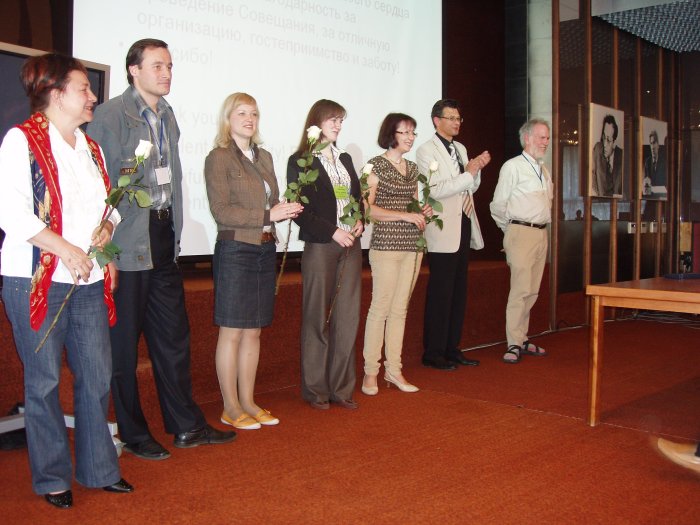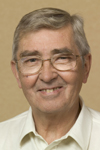Director's Corner
26 June 2008
Integrating ideas at Dubna
Today's issue features a Director's Corner by Ewan Paterson, Integration Specialist and Member of the GDE Executive Committee.
At the recent Conventional Facilities and Siting Workshop in Dubna, there were four focus groups: Shallow Site, Infrastructure, Siting and Accelerator Systems. However before the meetings formally began, the conveners of the latter two had integrated them into one. These conveners, Nikolai Solyak, Andrei Seryi, Masao Kuriki and myself, felt that the subjects had so much overlap and were so strongly coupled that it would be more productive for the parties involved to discuss them together. A charge to this joint focus group might be written as follows:
Examine possible sites and evaluate machine design differences that accommodate or make best use of these sites and begin a process that
a) rethinks the accelerator layout for lower costs
b) identifies new and innovative ideas for lower cost designs
c) begins defining a 'minimal' machine that could be staged to higher energy.
This process began with a review and update on the characteristics of the sample sites described in the Reference Design Report (RDR), including the requirements of a CLIC (Compact Linear Collider Study) technology design versus the ILC design at the CERN site. Most of the discussion revolved around the possible shallow site near Dubna where, because of the local geology and geomorphology, many conventional facilities and siting (CF&S) options are available which are quite different from the "deep" sites. Although cost studies have only begun for ILC layouts which make best use of the Dubna site, there was an unspoken consensus that the civil costs, especially in the interaction region, would be lower than those in the RDR.
 Marc Ross preparing his summary talk in Russian early on Friday. Marc Ross preparing his summary talk in Russian early on Friday. |
 Everyone including Marc thanking the local organisers. Everyone including Marc thanking the local organisers. |
We discussed several technical designs or layouts for the machine that had some common themes. The RDR is a conservative design. If one can make systems more compact and thus reduce the total tunnel length, then the CF&S costs go down faster than technical system costs (risks) increase! What are the tradeoffs in system performance, cost or operability? Examples included a shorter beam delivery system, alternative machine-detector interfaces, moving all sources and injectors to the central region, putting them in the same plane where they would share tunnel space with beam delivery systems, more compact bunch compressor systems in the 'ring to main linac' section, three-kilometre circumference damping rings with four rings in one tunnel (this may sound pretty wild but it would not be a first; CERN's PS booster uses the same system), a compact and less expensive positron keep alive source, and a few more.
Not all these ideas are can be applied simultaneously or will survive more detail study and evaluation. However, we feel that we can probably reduce the beam tunnel by several kilometres, ignoring the question of whether there is also a second support or service tunnel, and some corresponding reduction in technical system costs. These translate into very worthwhile cost reductions and justify further study. However, as usual 'the devil is in the details', and following each idea with a more complete technical design including accelerator lattices that incorporate the changes would be a very large longtime effort. We began the process of planning to review the proposals and we believe that the area system and conventional facility leaders together can come up with a single integrated proposal by the end of 2008 that would be studied in 2009. With the Global Design Effort's finite resources, these reviews would rely heavily on past design work, the RDR and best judgment. I believe an even better combination of ideas is likely to be an outcome of this process.
One of the outcomes of these changes in system layouts is that one can consider the ILC in two parts, a central region which is roughly five by three kilometres and two narrow extendable arms which are each ten kilometres long. The central region contains all accelerator and detector systems and their support functions and the arms contain linac systems with their support. The requirements for access points and frequency of access are likely to be different in these different regions and might be optimised differently. The linacs have a natural redundancy, whereas the injector and beam delivery systems have many one-off and critical components or instrumentation. The central region might be part of an existing campus or form a new campus which would include all the facilities necessary for a functioning international laboratory. If we include the end of the linacs in the central region (they belong there physically) along with the cryoplants etc, then additional access to the linacs from the surface and therefore impact on the surface in the form of more buildings would occur at the five- and ten-kilometre points and would be localised. This type of geometry would fit almost any site but would benefit from having the central region at a shallow depth, especially the interaction region. In addition to a level shallow site one could envision a central campus in a broad valley with the linac arms extending into the mountains.
From the view of the focus groups on siting and accelerator systems, this was a stimulating and productive workshop. As can be seen in the accompanying photos we are grateful to the local organisers for all their efforts.
-- Ewan Paterson
